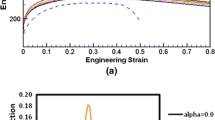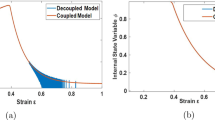Abstract
The prediction of fracture toughness for hierarchical materials remains a challenging research issue because it involves different physical phenomena at multiple length scales. In this work, we propose a multiscale process zone model based on linear elastic fracture mechanics and a multiscale micromorphic theory. By computing the stress intensity factor in a K-dominant region while maintaining the mechanism of failure in the process zone, this model allows the evaluation of the fracture toughness of hierarchical materials as a function of their microstructural properties. After introducing a multi-length scale finite element formulation, an application is presented for high strength alloys, whose microstructure typically contains two populations of particles at different length scales. For this material, the design parameters comprise of the strength of the matrix–particle interface, the particle volume fraction and the strain-hardening of the matrix. Using the proposed framework, trends in the fracture toughness are computed as a function of design parameters, showing potential applications in computational materials design.
Similar content being viewed by others
References
Aravas N, McMeeking RM (1985) Microvoid growth and failure in the ligament between a hole and a blunt crack tip. Int J Fract 29: 21–38
Baaser H, Gross D (2003) Analysis of void growth in a ductile material. Comput Mater Sci 26: 28–35
Belytschko T, Liu WK, Moran B (2000) Nonlinear finite elements for continua and structures. Wiley, New York
Chen JY, Wei Y, Huang Y, Hutchinson JW, Hwang KC (1999) The crack tip fields in strain gradient plasticity: the asymptotic and numerical analyses. Eng Fract Mech 64: 625–648
Ghosal AK, Narasimhan R (1996) Mixed-mode fracture initiation in a ductile material with a dual population of second-phase particles. Mater Sci Eng A 211: 117–127
Gurson AL (1977) Continuum theory of ductile rupture by void nucleation and growth. Part 1. Yield criteria and flow rules for porous ductile media. ASME J Eng Mater Technol 99: 2–15
Hao S, Liu WK, Moran B, Vernerey F, Olson GB (2004) Multiple-scale constitutive model and computational framework for the design of ultra-high strength, high toughness steels. Comput Methods Appl Mech Eng 193: 1865
Huang Y, Zhang TF, Guo TF, Hwang KC (1997) Mixed mode near-tip fields for cracks in materials with strain gradient effects. J Mech Phys Solids 45: 439–465
Hutchinson JW (1968) Plastic stress and strain fields at crack tip. J Mech Phys Solids 16(5): 337–347
Kanninen MF, Popelar CH (1985) Adv Fract Mech. Oxford Engineering Series, Oxford
Li S, Liu WK (2004) Meshfree particle methods. Springer, Heidelberg, p 502
Liu WK, McVeigh C (2008) Predictive multiscale theory for design of heterogeneous materials. Comput Mech 42(2): 147–170
Liu WK, Jun S, Zhang YF (1995a) Reproducing kernel particle methods. Int J Numer Methods Fluids 20: 1081–1106
Liu WK, Jun S, Li S, Adee J, Belytschko T (1995b) Reproducing kernel particle methods for structural dynamics. Int J Numer Methods Eng 38: 1655–1679
Liu WK, Karpov EG, Zhang S, Park HS (2004) An introduction to computational nanomechanics and materials. Comput Methods Appl Mech Eng 193: 1529–1578
Liu WK, Karpov EG, Parks HS (2006) Nano mechanics and materials, theory, multiscale, methods and applications. Wiley, New York
McVeigh C, Liu WK (2008a) Multiresolution modeling of ductile reinforced brittle composites. J Mech Phys Solids. doi:10.1016/j.jmps.2008.10.015
McVeigh C, Liu WK (2008b) Linking microstructure and properties through a predictive multiresolution continuum. Comput Methods Appl Mech Eng 197: 3268–3290
McVeigh C, Vernerey F, Liu WK, Brinson LC (2006) Multiresolution analysis for material design. Comput Methods Appl Mech Eng 95:37–40, 5053–5076
McVeigh C, Vernerey F, Liu WK, Moran B (2007) An interactive microvoid shear localization mechanism in high strength steels. J Mech Phys Solids 55:2, 225–244
Needleman A, Tvergaard V (1984) An analysis of ductile rupture in notched bars. J Mech Phys Solids 32: 461–490
Needleman A, Tvergaard V (1987) An analysis of ductile rupture modes at a crack tip. J Mech Phys Solids 35(2): 151–183
Needleman A, Tvergaard V (1998) Dynamic crack growth in a nonlocal progressively cavitating solid. Eur J Mech A/Solids 17: 421–438
Pardoen T, Hutchinson JW (2003) Micromechanics-based model for trends in toughness of ductile metals. Acta Mater 51(1): 133–148
Rice JR (1967) A path independent integral and the approximate analysis of strain concentration by notches and cracks. Report: E39, 49p
Rice JR, Johnson MA et al (1970) The role of large crack tip geometry changes in plane strain fracture. In: Kanninen MF(eds) Inelastic behavior of Solids. McGraw-Hill, New York, pp 641–672
Tvergaard V (1988) 3d-analysis of localization failure in a ductile material containing two size-scales of spherical particles. Eng Fract Mech 31: 421–436
Tvergaard V, Hutchinson JW (1992) The relation between crack growth resistance and fracture process parameters in elastic–plastic solids. J Mech Phys Solids 40: 1377
Tvergaard V, Hutchinson JW (1996) On the toughness of ductile adhesive joints. J Mech Phys Solids 44: 789–800
Vernerey FJ, McVeigh C, Liu WK, Moran B, Tewari D, Parks D, Olson G (2006) The 3D computational modeling of shear dominated ductile failure of steel. J Minerals Metals Mater Soc, pp 45–51
Vernerey F, Liu WK, Moran B (2007) Multiscale micromorphic theory for hierarchical materials. J Mech Phys Solids 55(12): 2603–2651
Vernerey F, Liu WK, Moran B, Olson GB (2008) A micromorphic model for the multiple scale failure of heterogeneous materials. J Mech Phys Solids 56(4): 1320–1347
Xia ZC, Hutchinson W (1996) Crack tip fields in strain gradient plasticity. J Mech Phys Solids 44: 1621–1648
Xia ZC, Shih CF (1995a) Ductile crack growth—numerical study using computational cells with microstrucurally-based length scales. J Mech Phys Solids 43: 233–259
Xia ZC, Shih CF (1995b) Ductile crack growth. II. Void nucleation and geometry effects on macroscopic fracture behavior. J Mech Phys Solids 43: 1953–1981
Xia ZC, Shih CF, Hutchinson W (1994) A computational approach to ductile crack growth under large scale yielding conditions. J Mech Phys Solids 43: 389–413
Yan C, Mai YW (1998) Effect of constraint on void growth near a blunt crack tip. Int J Fract 92: 287–304
Author information
Authors and Affiliations
Corresponding authors
Rights and permissions
About this article
Cite this article
Vernerey, F., Liu, W.K., Moran, B. et al. Multi-length scale micromorphic process zone model. Comput Mech 44, 433–445 (2009). https://doi.org/10.1007/s00466-009-0382-7
Received:
Accepted:
Published:
Issue Date:
DOI: https://doi.org/10.1007/s00466-009-0382-7




